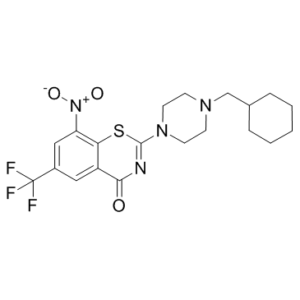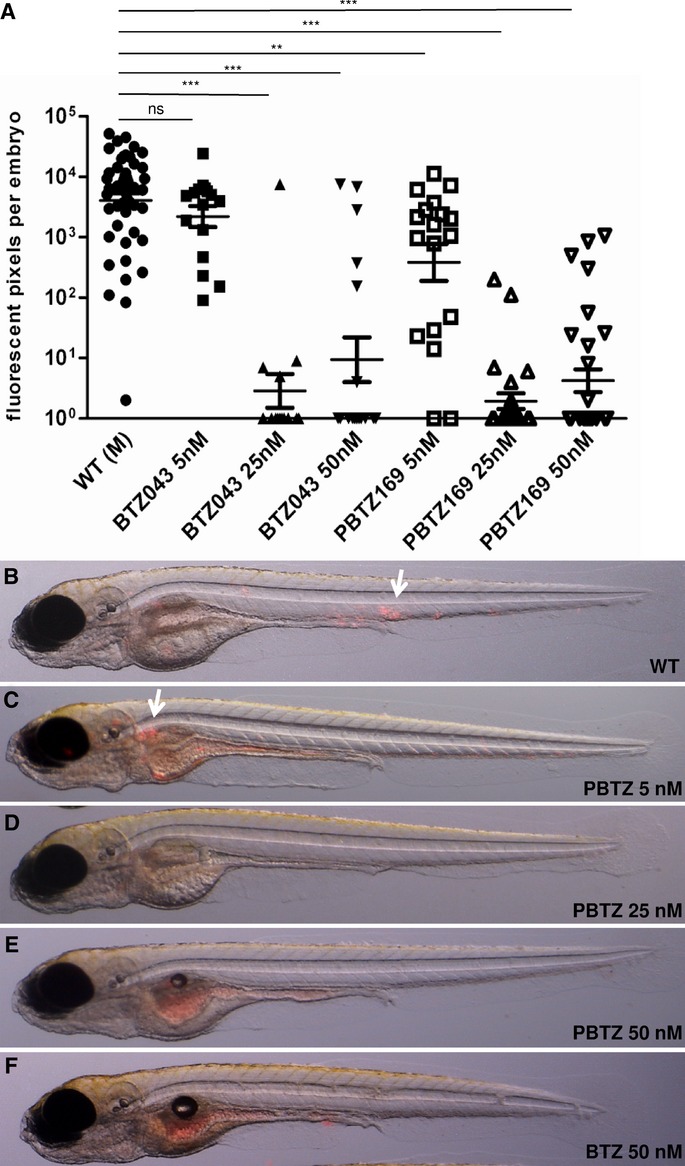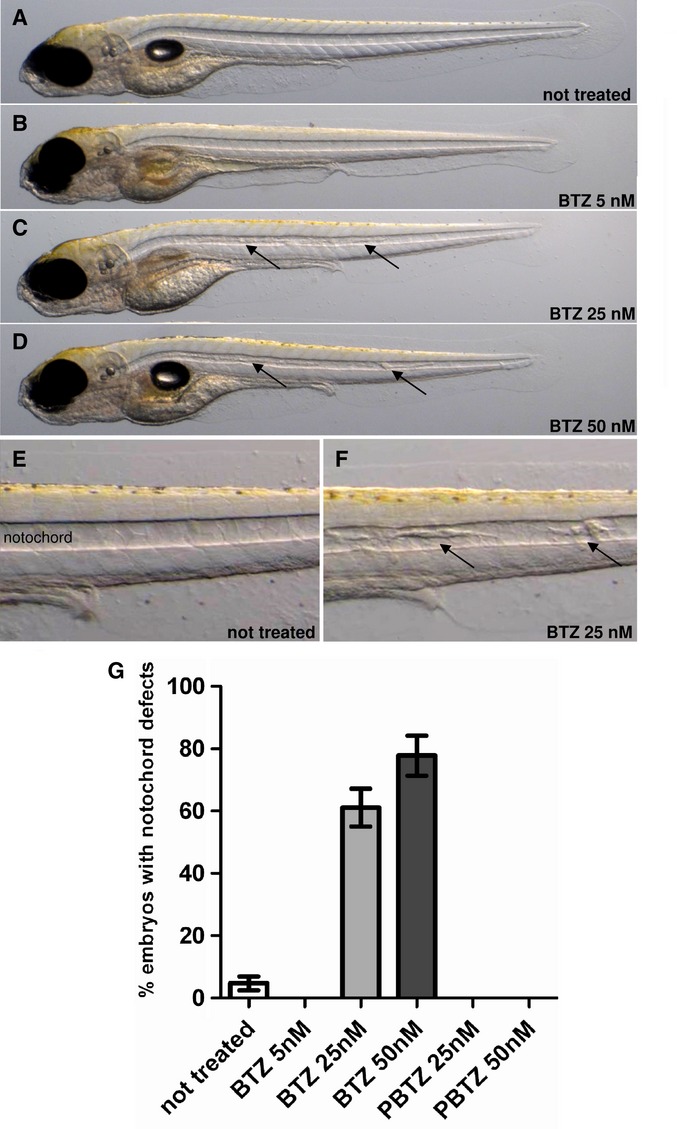This product is for research use only, not for human use. We do not sell to patients.

| Size | Price | Stock |
|---|---|---|
| 250mg | $750 | Check With Us |
| 500mg | $1350 | Check With Us |
| 1g | $2025 | Check With Us |
Cat #: V3009 CAS #: 1377239-83-2 Purity ≥ 98%
Description: PBTZ169 (PBTZ-169; Macozinone, an 8-Nitro-benzothiazinones (BTZs) analog) is a novel inhibitor of decaprenyl-phosphoribose-epimerase (DprE1) that displays nanomolar bactericidal activity against Mycobacterium tuberculosis in vitro. DprE1 is an essential enzyme involved in the cell wall biosynthesis of Corynebacterineae. Structure-activity relationship (SAR) studies revealed the 8-nitro group of the BTZ scaffold to be crucial for the mechanism of action, which involves formation of a semimercaptal bond with Cys387 in the active site of DprE1. When tested against thirty Nocardia brasiliensis isolates, the MIC50 and MIC90 values for PBTZ169 were 0.0075 and 0.03 μg/mL, respectively. Because Nocardia is a potential intracellular bacterium, a THP-1 macrophage monolayer was infected with N. brasiliensis HUJEG-1 and then treated with PBTZ169, resulting in a decrease in the number of colony-forming units (CFUs) at a concentration of 0.25X the in vitro value. The in vivo activity was evaluated after infecting female BALB/c mice in the right hind food-pad. After 6 weeks, treatment was initiated with PBTZ169 and its activity was compared with the first generation compound, BTZ043. Both BTZ compounds were administered at 100 mg/kg twice daily by gavage, and sulfamethoxazole/trimethoprim (SXT), at 100 mg/kg sulfamethoxazole, was used as a positive control. After 22 weeks of therapy, only PBTZ169 and SXT displayed statistically significant activity.
Publications Citing InvivoChem Products
Product Promise

- Physicochemical and Storage Information
- Protocol
- Related Biological Data
- Stock Solution Preparation
- Quality Control Documentation
| Molecular Weight (MW) | 456.48 |
|---|---|
| Molecular Formula | C20H23F3N4O3S |
| CAS No. | 1377239-83-2 |
| Storage | -20℃ for 3 years in powder formr |
| -80℃ for 2 years in solvent | |
| Solubility In Vitro | DMSO: 6.4 mg/mL (Need ultrasonic)r |
| Water: <1 mg/mLr | |
| Ethanol: <1 mg/mL | |
| SMILES Code | O=C1N=C(N2CCN(CC3CCCCC3)CC2)SC4=C([N+]([O-])=O)C=C(C(F)(F)F)C=C14 |
| Synonyms | PBTZ-169; Macozinone; PBTZ169; PBTZ 169 |
| Protocol | In Vitro | In vitro activity: PBTZ169 (also known as Macozinone, an 8-Nitro-benzothiazinones (BTZs) analog) is a novel inhibitor of decaprenyl-phosphoribose-epimerase (DprE1) that displays nanomolar bactericidal activity against Mycobacterium tuberculosis in vitro. DprE1 is an essential enzyme involved in the cell wall biosynthesis of Corynebacterineae. Structure-activity relationship (SAR) studies revealed the 8-nitro group of the BTZ scaffold to be crucial for the mechanism of action, which involves formation of a semimercaptal bond with Cys387 in the active site of DprE1. When tested against thirty Nocardia brasiliensis isolates, the MIC50 and MIC90 values for PBTZ169 were 0.0075 and 0.03 μg/mL, respectively. Because Nocardia is a potential intracellular bacterium, a THP-1 macrophage monolayer was infected with N. brasiliensis HUJEG-1 and then treated with PBTZ169, resulting in a decrease in the number of colony-forming units (CFUs) at a concentration of 0.25X the in vitro value. The in vivo activity was evaluated after infecting female BALB/c mice in the right hind food-pad. After 6 weeks, treatment was initiated with PBTZ169 and its activity was compared with the first generation compound, BTZ043. Both BTZ compounds were administered at 100 mg/kg twice daily by gavage, and sulfamethoxazole/trimethoprim (SXT), at 100 mg/kg sulfamethoxazole, was used as a positive control. After 22 weeks of therapy, only PBTZ169 and SXT displayed statistically significant activity. Kinase Assay: PBTZ169, inhibit decaprenylphosphoryl-β-d-ribose 2′-oxidase (DprE1) and display nanomolar bactericidal activity against Mycobacterium tuberculosis in vitro Cell Assay: When tested against thirty Nocardia brasiliensis isolates, the MIC50 and MIC90 values for PBTZ169 were 0.0075 and 0.03 μg/mL, respectively. Because Nocardia is a potential intracellular bacterium, a THP-1 macrophage monolayer was infected with N. brasiliensis HUJEG-1 and then treated with PBTZ169, resulting in a decrease in the number of colony-forming units (CFUs) at a concentration of 0.25X the in vitro value. |
|---|---|---|
| In Vivo | The in vivo activity was evaluated after infecting female BALB/c mice in the right hind food-pad. After 6 weeks, treatment was initiated with PBTZ169 and its activity was compared with the first generation compound, BTZ043. Both BTZ compounds were administered at 100 mg/kg twice daily by gavage, and sulfamethoxazole/trimethoprim (SXT), at 100 mg/kg sulfamethoxazole, was used as a positive control. After 22 weeks of therapy, only PBTZ169 and SXT displayed statistically significant activity. PBTZ169 can be suspend in 0.25% hydroxy-propylmethyl-cellulose. The administertration for PBTZ169 is 100 mg/kg by gavage. The MIC50 and MIC90 values were 0.0075 and 0.030 μg/mL, respectively. The MIC for PBTZ169 for N. brasiliensis HUJEG-1 was 0.0037 μg/mL. | |
| Animal model | BALB/c mice |
| Solvent volume to be added | Mass (the weight of a compound) | |||
|---|---|---|---|---|
| Mother liquor concentration | 1mg | 5mg | 10mg | 20mg |
| 1mM | 2.1907 mL | 10.9534 mL | 21.9068 mL | 43.8135 mL |
| 5mM | 0.4381 mL | 2.1907 mL | 4.3814 mL | 8.7627 mL |
| 10mM | 0.2191 mL | 1.0953 mL | 2.1907 mL | 4.3814 mL |
| 20mM | 0.1095 mL | 0.5477 mL | 1.0953 mL | 2.1907 mL |
This equation is commonly abbreviated as: C1 V1 = C2 V2
- (1) Please be sure that the solution is clear before the addition of next solvent. Dissolution methods like vortex, ultrasound or warming and heat may be used to aid dissolving.
- (2) Be sure to add the solvent(s) in order.







































